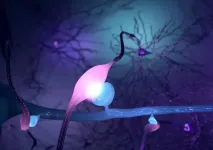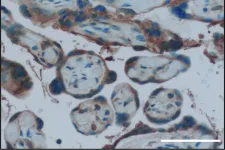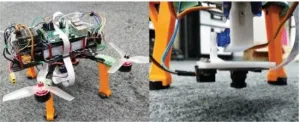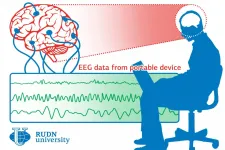(Press-News.org) Early Medieval Europe is frequently viewed as a time of cultural stagnation, often given the misnomer of the 'Dark Ages'. However, analysis has revealed new ideas could spread rapidly as communities were interconnected, creating a surprisingly unified culture in Europe.
Dr Emma Brownlee, Department of Archaeology, University of Cambridge, examined how a key change in Western European burial practices spread across the continent faster than previously believed - between the 6th - 8th centuries AD, burying people with regionally specific grave goods was largely abandoned in favour of a more standardised, unfurnished burial.
"Almost everyone from the eighth century onwards is buried very simply in a plain grave, with no accompanying objects, and this is a change that has been observed right across western Europe," said Dr Brownlee.
To explore this change, Emma examined over 33,000 graves from this period in one of the largest studies of its kind. Statistical analysis was used to create a 'heat map' of the practice, tracking how it changed in frequency over time.
The results of this analysis, published in the journal Antiquity, reveal that changes in grave good use began to decline from the mid-sixth century in England, France, Germany, and the Low Countries, and by the early eighth century, it had been abandoned entirely.
"The most important finding is that the change from burial with grave goods to burial without them was contemporary across western Europe," said Dr Brownlee. "Although we knew this was a widespread change before, no one has previously been able to show just how closely aligned the change was in areas that are geographically very far apart."
Crucially, this contemporary transition provides strong evidence that early Medieval Europe was a well-connected place, with regular contact and exchange of ideas across vast areas.
Evidence of increasing long-distance trade is seen around this period, which may have been how these connections were facilitated. As the idea spread between communities, social pressure drove more people to adopt it. As more people did, this pressure grew - explaining why the spread of unfurnished funerals appeared to accelerate over time.
With people sharing more similarities, this likely reinforced the connections themselves as well.
"The change in burial practice will have further reinforced those connections; with everyone burying their dead in the same manner, a medieval traveller could have gone anywhere in Europe and seen practices they were familiar with," said Dr Brownlee.
An interconnected Europe with long-distance trade and travel facilitating the spread of new ideas to create a shared culture may sound modern, but in reality, Europe has been 'global' for over a millennium.
INFORMATION:
As scientists increasingly rely on eyewitness accounts of earthquake shaking reported through online systems, they should consider whether those accounts are societally and spatially representative for an event, according to a new paper published in Seismological Research Letters.
Socioeconomic factors can play a significant if complex role in limiting who uses systems such as the U.S. Geological Survey's "Did You Feel It?" (DYFI) to report earthquake shaking. In California, for instance, researchers concluded that DYFI appears to gather data across a wide socioeconomic range, albeit with some intriguing differences related to neighborhood income levels during earthquakes such as the ...
The neocortex is the part of the brain that humans use to process sensory impressions, store memories, give instructions to the muscles, and plan for the future. These computational processes are possible because each nerve cell is a highly complex miniature computer that communicates with around 10,000 other neurons. This communication happens via special connections called synapses.
The bigger the synapse, the stronger its signal
Researchers in Kevan Martin's laboratory at the Institute of Neuroinformatics at the University of Zurich (UZH) and ETH Zurich have now shown for the first time that the size of synapses determines the strength of their ...
TAMPA, Fla. -- Myelodysplastic Syndromes (MDS) and acute myeloid leukemia (AML) are rare hematologic malignancies of the bone marrow. They can occur spontaneously or secondary to treatment for other cancers, so called therapy related disease, which is frequently associated with a mutation of the tumor suppressor gene TP53. Standard treatment for these patients includes hypomethylating agents such as azacitidine or decitabine but unfortunately outcomes are very poor.
"Patients with TP53-mutant disease, which is roughly 10% to 20% of AML and de novo MDS cases, don't have many options ...
Growing perennial grasses on abandoned cropland has the potential to counteract some of the negative impacts of climate change by switching to more biofuels, according to a research group from the Norwegian University of Science and Technology (NTNU).
Researchers consider increased use of biofuels to be an important part of the solution to reduce CO2 emissions. But the production of plants for biofuels can have some unfortunate trade-offs.
Now, the NTNU researchers have come up with a scenario that would put less pressure on food production and plant and animal life.
"We can grow perennial grasses in areas that until recently were used for growing food but that are no longer used for that purpose," explains Jan Sandstad ...
DURHAM, N.C. - Researchers at Duke and Mt. Sinai have identified a molecular mechanism that prevents a viral infection during a mother's pregnancy from harming her unborn baby.
When a person becomes infected by a virus, their immune system sends out a chemical signal called type I interferon, which tells surrounding cells to increase their anti-viral defenses, including making more inflammation.
This response helps to prevent the virus from copying itself and gives the adaptive immune system more time to learn about the new invader and begin to hunt it down.
A pregnant woman ...
Initially earmarked for covert military operations, unmanned aerial vehicles (UAVs) or drones have since gained tremendous popularity, which has broadened the scope of their use. In fact, "remote pilot" drones have been largely replaced by "autonomous" drones for applications in various fields. One such application is their usage in rescue missions following a natural or man-made disaster. However, this often requires the drones to be able to land safely on uneven terrain--which can be very difficult to execute.
"While it is desirable to automate the landing using a depth camera that can gauge terrain unevenness and find suitable landing spots, a framework serving as a useful base needs to be developed first," ...
A neurosurgeon from RUDN University studied the mental activity of developers at work. In his novel method, he combined mobile EEG devices and software that analyzes neurophysiological data. The results of the study were published in the materials of the 23rd Euromicro Conference on Digital System Design (DSD).
To collect data about the activity of specific areas of the brain, one can use functional magnetic resonance imaging (fMRI). However, this method involves massive equipment and is only available at clinics or laboratories. Therefore, it is quite difficult to register human mental activity in a natural environment. Even if usual conditions are reproduced in a lab, the very fact that it is an experiment would still affect the behavior of the participants. ...
Peer-reviewed / Modelling / People
UK modelling study estimates 59% of SARS-CoV-2 transmission may be prevented by completing the WHO recommended 14-day quarantine period after exposure to a confirmed COVID-19 case
Model assumes that quarantine adherence levels are moderate, with 67% of people completing the recommended 14-day isolation period after testing positive for COVID-19 and 50% of contacts of confirmed cases completing 14 days of quarantine.
A similar proportion of transmission could be prevented with only 7 days of quarantine (assuming the same level of adherence) if a COVID-19 ...
In normal times, end-of-life care discussions are most commonly led by senior doctors. However, new research from a busy London hospital shows that the high numbers of deaths taking place in hospitals during the COVID-19 pandemic, frequently out-of-hours, is leading to junior (foundation level) doctors having to lead on these difficult discussions with families, often with no formal experience or training.
The study is by Dr Edmund Lodwick, King's College Hospital NHS Trust, London, UK, and presented at this month's Winter Scientific Meeting of the Association of Anaesthetists, held online. He analysed the situation at Croydon University Hospital, London, where he spent his own foundation level training. This is a typically busy London hospital ...
Researchers say they have been able to greatly improve the readout of data from digital memories - thanks to a phenomenon known as 'quantum entanglement'.
The research team, which included researchers from the Italian Institute of Metrological Research (INRIM) and the University of York, say the findings could have major applications for digital storage devices, including optical memories such as CD or BluRay disks.
This is the first experimental demonstration that quantum sources of light can enhance the readout of information from digital memories, an advance that could potentially lead to faster access of data in large databases and to construct memories with higher capacities in our next-generation computers.
In an ...



